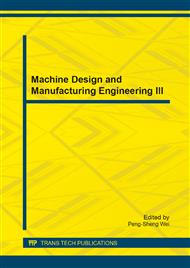[1]
Chen, D., Liu, S., Li, J., Zhao, N., Shi, C., Du, X. and Sheng, J. (2009). Nanometre Ni and core/shell Ni/Au nanoparticles with controllable dimensions synthesized in reverse microemulsion. Journal of Alloys and Compound. 475, 494-500.
DOI: 10.1016/j.jallcom.2008.07.115
Google Scholar
[2]
Qian, L. and Yang, X. (2005). Preparation and characterization of Ag(Au) bimetallic core-shell nanoparticles with new seed growth method. Colloids and Surfaces A: Physicochemical Engineering Aspects. 260, 79-85.
DOI: 10.1016/j.colsurfa.2005.03.005
Google Scholar
[3]
Chen, D., Li, J., Shi, C., Du, X., Zhao, N., Sheng, J., and Liu, S. (2007). Properties of Core-Shell Ni-Au Nanoparticles Synthesized through a Redox-Transmetalation Method in Reverse Microemulsion. Chemistry of Materials. 19, 3399-3405.
DOI: 10.1021/cm070182x
Google Scholar
[4]
Bao, Y. and Krishnan, K.M. (2005). Preparation of functionalized and gold-coated cobalt nanocrystals for biomedical application. Journal of Magnetism and Magnetic Materials. 293, 15-19.
DOI: 10.1016/j.jmmm.2005.01.037
Google Scholar
[5]
Chen, G. and Walker A.R.H. (2007). Synthesis and characterization of cobalt/gold bimetallic nanoparticles, Journal of Magnetism and Magnetic Materials, 311, 31–35.
DOI: 10.1016/j.jmmm.2006.11.164
Google Scholar
[6]
Reetz, M. T., Helbig, W. and Quaiser, S. A. (1995). Electrochemical Preparation of Nanostructural Bimetallic Clusters. Chemistry of Materials. 7 (12), 2227–2228.
DOI: 10.1021/cm00060a004
Google Scholar
[7]
Auten, B.J., Hahn, B.P., Vijayaraghavan, G., Stevenson, K.J. and Chandler, B.D. (2008). Preparation and characterization of 3 nm magnetic NiAu nanoparticles, Journal of Physics and Chemistry C. 112, 5365-5372.
DOI: 10.1021/jp076982c
Google Scholar
[8]
Chen and Wang, (2006).
Google Scholar
[9]
Lee, C.C., Cheng, Y.Y., Chang, H.Y. and Chen, D.H. (2009). Synthesis and electromagnetic wave absorption property of Ni-Ag alloy nanoparticles. Journal of Alloys and Compounds. 480, 674-680.
DOI: 10.1016/j.jallcom.2009.02.017
Google Scholar
[10]
Mandal, S. and Krishnan, K. M. (2007). CocoreAushell nanoparticles: evolution of magnetic properties in the displacement reaction. Journal of Materials Chemistry. 17, 372-376.
Google Scholar
[11]
N.R. Nik Roselina, A. Azizan, Z. Lockman, (2012). Synthesis of Nickel Nanoparticles via Non-Aqueous Polyol Method: Effect of Reaction Time, Sains Malaysiana. 41, 1037-1042.
Google Scholar
[12]
N.R. Nik Roselina, A. Azizan, Koay Mei Hyie, C.M. Mardziah, S. Kasolang, S.K. Alias and Z. Salleh, Synthesis route towards fine and monodisperse Ni nanoparticles via hot-injection approach, Applied Mechanics and Materials. 393 (2013). 146-151.
DOI: 10.4028/www.scientific.net/amm.393.146
Google Scholar
[13]
Amendola, V., Polizzi, S., and Meneghetti, M. (2006). Laser Ablation Synthesis of Gold Nanoparticles in Organic Solvents. Journal of Physical Chemistry B. 110, 7232-7237.
DOI: 10.1021/jp0605092
Google Scholar
[14]
Bala, T., Swami, A., Prasad, B.L.V. and Sastry, M. (2005). Phase transfer of oleic acid capped NicoreAgshell nanoparticles assisted by the flexibility of oleic acid on the surface of silver. Journal of Colloid and Interface Science. 283, 422-431.
DOI: 10.1016/j.jcis.2004.09.018
Google Scholar
[15]
Bhattacharya, S., and Srivastava, A. (2003). Synthesis of gold nanoparticles stabilised by metal-chelator and the controlled formation of close-packed aggregates by them. Journal of Chemical Sciences. 115, 613–619.
DOI: 10.1007/bf02708252
Google Scholar
[16]
M. Dasog and R.W.J. Scott. (2007). Understanding the oxidative stability of gold monolayer-protected clusters in the presence of halide ions under ambient condition. Langmuir. 23, 3381-3387.
DOI: 10.1021/la0627415
Google Scholar
[17]
Toshima, N., Harada, M., Yamazaki, Y. and Asakura, K. (1992).
Google Scholar
[18]
Rousset, J.L., Aires, F.J.C.S., Sekhar, B.R., Melinon, P., Prevel, B. and Pellarin, M. (2000).
Google Scholar


